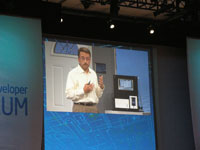IDF Day 1: Pat Gelsinger Keynote: Embedded + Dynamic + Visual
IDF Day 1: Pat Gelsinger Keynote: "IA= Embedded + Dynamic + Visual"
While Craig Barrett delivered a rather non-technical, but socially-charged keynote earlier in the day, Pat Gelsinger's (Intel Senior Vice President and General Manager, Digital Enterprise Group) keynote address by contrast was all about the tech.
Gelsinger envisions tomorrow's Internet as fully pervasive. The Internet will touch any device that communicates. As processors continue to become increasingly power efficient and faster, they will become more scalable and will be utilized in more products and platforms--including those that perhaps we are not used to thinking as traditionally Internet connected. Gelsinger calls this future of the Internet the "embedded Internet." He says it will be "different, but familiar."
Gelsinger says that technologies will weave themselves into everyday life in the near future, so that every being will be connected to the Internet 24/7--whether we are playing, working, learning, or resting. He predicts that there will be 15 billion devices connected to the Internet by 2015.
For this to happen, though, a number of barriers need to be breached:
(Gelsinger says that current predictions hold that all IPv4 address space will be exhausted by 2011, and that we'll need to move to the IPv6 architecture.)
Traditional Intel Architecture (IA) products are already in the embedded marketplace with Xeon, Core 2, and Centrino processors. Intel's Atom processor is aimed exclusively at Internet-enabled devices, such as MIDs, Netops, and other Internet-enabled small form factor devices. Just in the last two quarters since Intel announced Atom, there are over 700 Atom-based "design engagements." Many of these are new business opportunities in the medical, entertainment, and defense fields.
One example of an embedded Internet application was from when Gelsinger actually started his keynote: He came through a faux door that unlocked automatically when the Atom-based, facial-recognition, security system recognized him. The device was connected to a complete home control system that could audibly inform a user how many e-mail messages were waiting for him or let him monitor a home's energy usage.
Another example of an embedded Internet application is OpenPeak's OpenFrame IP/Media phone solution--a small desk-based device that in addition to being an IP-based phone also provides connected information, such as news, weather, stocks, traffic, appointments, or contacts. During a video presentation, OpenPeak CEO, Dan Gittleman, claims that moving the device to the Atom IA32 platform "was probably one of greatest moves we ever made."
The next example of an embedded Internet application that Gelsinger rolled out was a customized BMW convertible with an integrated infotainment system running an Atom processor. The car included a 3D navigation system that provided audible point-of-interest details, and backseat touch-sensitive displays with Internet access via WiMax. This particular example of telematics was a proof of concept by Intel and Wind River, and represents an open standard that the two companies are promoting. The BMW Group, Nissan, and Daimler have expressed interest in the open standard.
Gelsinger envisions tomorrow's Internet as fully pervasive. The Internet will touch any device that communicates. As processors continue to become increasingly power efficient and faster, they will become more scalable and will be utilized in more products and platforms--including those that perhaps we are not used to thinking as traditionally Internet connected. Gelsinger calls this future of the Internet the "embedded Internet." He says it will be "different, but familiar."
Gelsinger says that technologies will weave themselves into everyday life in the near future, so that every being will be connected to the Internet 24/7--whether we are playing, working, learning, or resting. He predicts that there will be 15 billion devices connected to the Internet by 2015.
For this to happen, though, a number of barriers need to be breached:
- Reliability and long life
- Software scalability
- Low power and low cost
- Privacy and data security
- IPv4 addressing
- Open standards
(Gelsinger says that current predictions hold that all IPv4 address space will be exhausted by 2011, and that we'll need to move to the IPv6 architecture.)
Traditional Intel Architecture (IA) products are already in the embedded marketplace with Xeon, Core 2, and Centrino processors. Intel's Atom processor is aimed exclusively at Internet-enabled devices, such as MIDs, Netops, and other Internet-enabled small form factor devices. Just in the last two quarters since Intel announced Atom, there are over 700 Atom-based "design engagements." Many of these are new business opportunities in the medical, entertainment, and defense fields.
One example of an embedded Internet application was from when Gelsinger actually started his keynote: He came through a faux door that unlocked automatically when the Atom-based, facial-recognition, security system recognized him. The device was connected to a complete home control system that could audibly inform a user how many e-mail messages were waiting for him or let him monitor a home's energy usage.
Another example of an embedded Internet application is OpenPeak's OpenFrame IP/Media phone solution--a small desk-based device that in addition to being an IP-based phone also provides connected information, such as news, weather, stocks, traffic, appointments, or contacts. During a video presentation, OpenPeak CEO, Dan Gittleman, claims that moving the device to the Atom IA32 platform "was probably one of greatest moves we ever made."
The next example of an embedded Internet application that Gelsinger rolled out was a customized BMW convertible with an integrated infotainment system running an Atom processor. The car included a 3D navigation system that provided audible point-of-interest details, and backseat touch-sensitive displays with Internet access via WiMax. This particular example of telematics was a proof of concept by Intel and Wind River, and represents an open standard that the two companies are promoting. The BMW Group, Nissan, and Daimler have expressed interest in the open standard.















